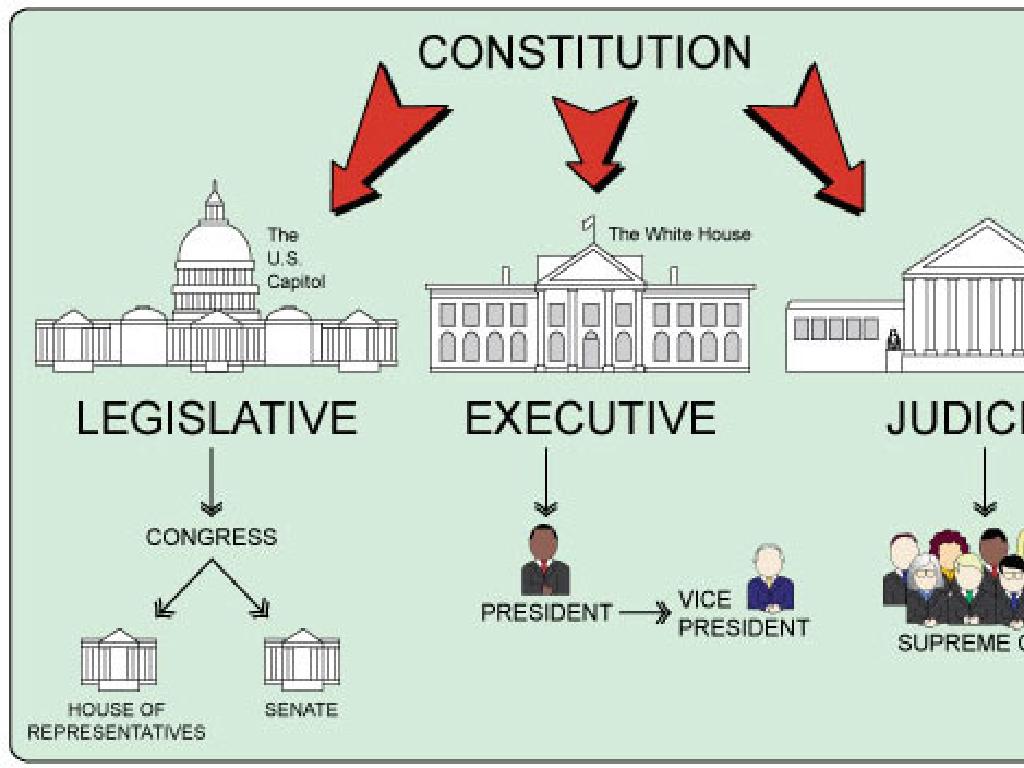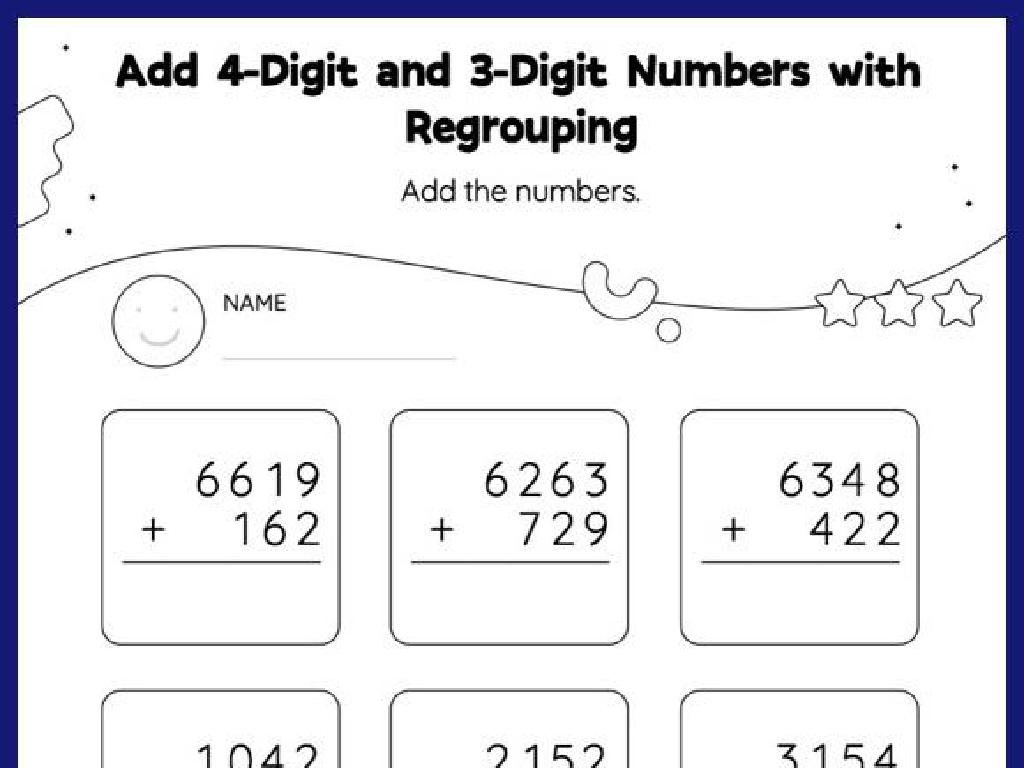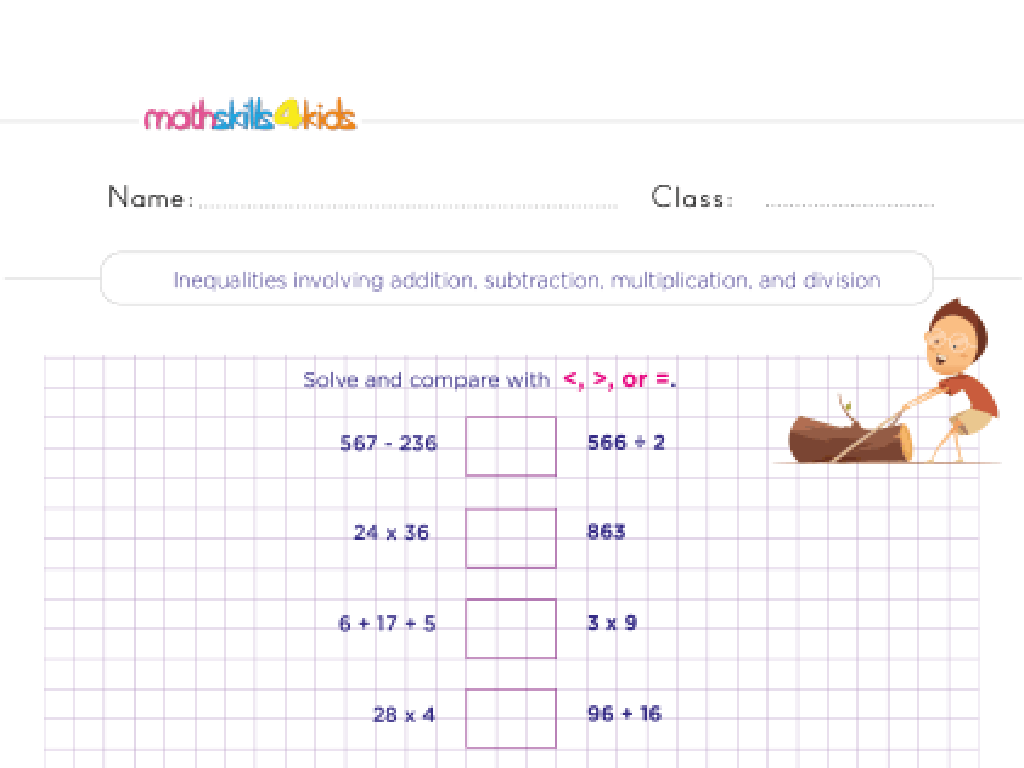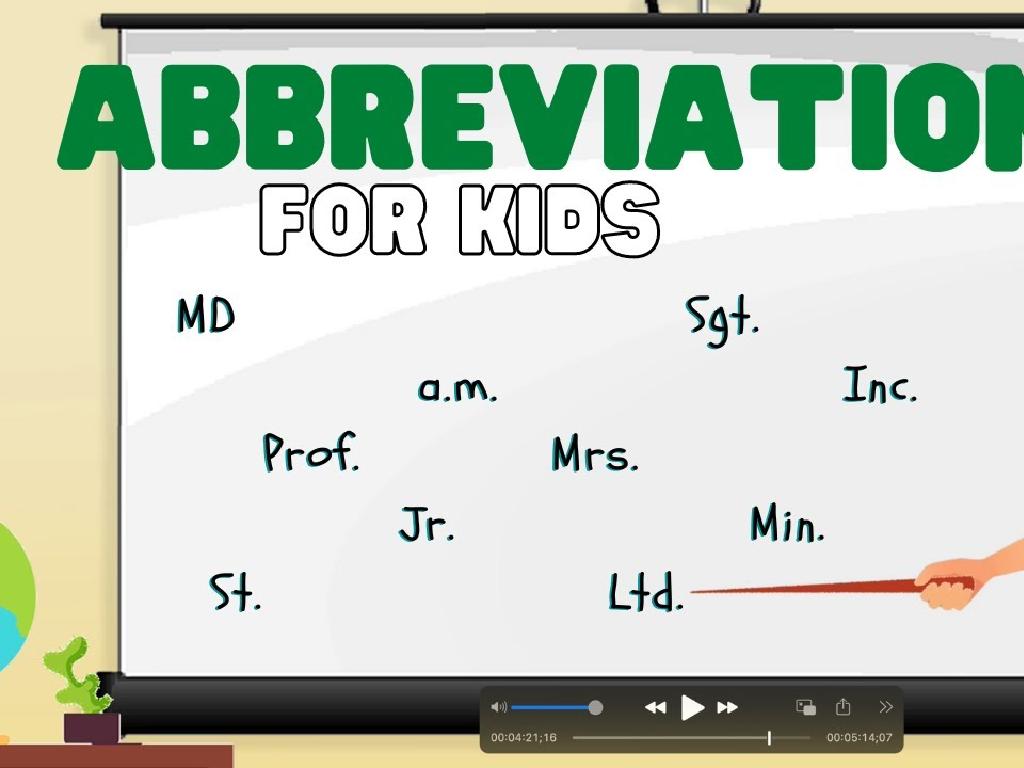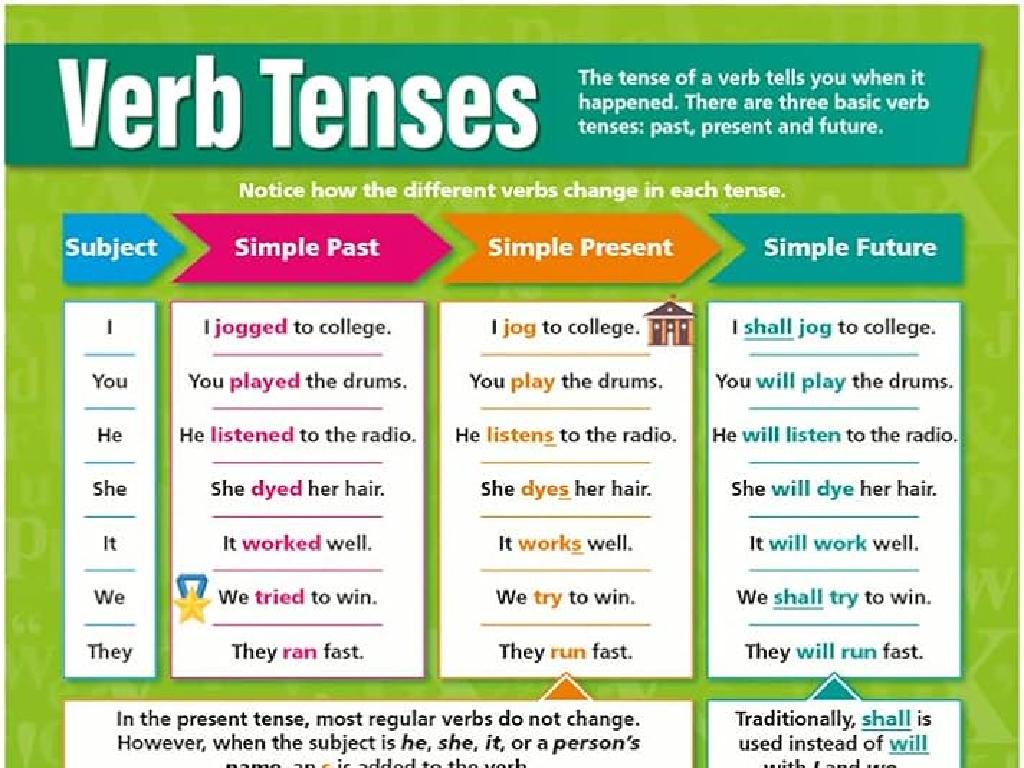Classify And Sort By Shape
Subject: Math
Grade: Pre-k
Topic: Classify
Please LOG IN to download the presentation. Access is available to registered users only.
View More Content
Welcome to Shapes!
– Greet our little explorers
– Today’s play: Learning shapes!
– Naming shapes in our world
– Look around, what shapes do you find? Circles? Squares?
– Fun shape discovery activity
– We’ll find and name shapes together in class!
|
This slide is designed to excite and engage Pre-K students at the beginning of a lesson on shapes. Start with a warm and enthusiastic greeting to capture their attention. Explain that today’s class will be fun and interactive, focusing on identifying and naming different shapes. Encourage the children to look around and name any shapes they recognize, such as the circle of a clock or the square of a window. This will help them connect the lesson to the real world. The activity should be hands-on, allowing the children to explore and discover shapes in a playful manner. As a teacher, be prepared to guide them through the activity, offering praise and support as they learn.
Exploring Shapes Around Us
– What is a shape?
– Shapes are forms we see everywhere
– Shapes have sides and corners
– Some shapes have 3 sides, some have 4!
– Common shapes we see
– We’ll learn about shapes we see every day
– Circle, square, triangle, rectangle
– No sides, 4 equal sides, 3 sides, 4 sides but 2 long 2 short
|
This slide introduces the concept of shapes to Pre-K students. Begin by explaining that shapes are the forms of things we see all around us, like the wheels on a bus (circles) or the windows on a house (squares). Highlight that shapes can have different numbers of sides and corners, such as triangles with 3 sides and rectangles with 4. Use physical objects in the classroom to show these shapes in a tangible way. Encourage the children to identify and classify objects based on their shapes. This will help them understand the concept of classification by shape and recognize patterns in their environment.
Let’s Learn About Circles!
– A circle is a round shape
– Circles have no corners
– Circles have no sides
– Find round things like a circle
– Examples: a clock, a coin, or a button
|
This slide introduces the concept of a circle to Pre-K students. Emphasize the roundness of the circle and explain that unlike some other shapes, circles do not have corners or sides. Encourage the children to look around their environment to find objects that are round like a circle, which will help them understand the concept better. Suggest they look for everyday items such as clocks, coins, or buttons. During the activity, walk around the classroom to see the objects students have found and discuss why they are or are not like a circle. This will help them to classify and sort objects based on their shapes.
Learning About Squares
– A square has four sides
– Each side is equal in length
– Counting the sides of a square
– Let’s count together: 1, 2, 3, 4!
– Recognizing squares around us
– Find objects shaped like squares
|
This slide introduces the concept of a square to Pre-K students. Start by showing them a square and pointing out the four sides. Emphasize that all sides of a square are the same length, which makes it special. Engage the students by counting the sides of the square out loud together. This interactive approach helps them remember the properties of a square. Finally, encourage the students to look around their environment, both in the classroom and at home, to find objects that are shaped like squares. This real-world connection reinforces their understanding and recognition of squares in everyday life.
Learning Shapes: The Triangle
– A triangle has three sides
– It’s a shape with 1, 2, 3 straight sides!
– Trace the sides with fingers
– Use your finger to follow along each side.
– Triangles are like pizza slices
– Imagine a yummy pizza slice shape.
|
This slide introduces the triangle to Pre-K students by relating it to familiar objects and involving a tactile activity. Start by explaining that a triangle is a simple shape with three straight sides. Encourage the children to use their fingers to trace the sides of a triangle on a page or in the air, which helps with their fine motor skills and shape recognition. Relate the triangle to something they know and love, like a slice of pizza, to make the concept more engaging and memorable. During the activity, walk around the classroom to ensure each student is tracing correctly and recognizing the shape. Offer praise and gentle corrections as needed.
Let’s Learn About Rectangles!
– A rectangle has four sides
– Two sides are long, and two are short
– Rectangles look like doors or books
– Think of your bedroom door or a favorite storybook
– Sorting rectangles from other shapes
– Find objects shaped like rectangles in the classroom
|
This slide introduces the rectangle to Pre-K students by highlighting its key properties and relating it to familiar objects. Start by explaining that a rectangle is a shape with four sides, making sure to emphasize that it has two longer opposite sides and two shorter opposite sides. Use everyday examples like a door or a book to help children visualize and remember what a rectangle looks like. Encourage the students to look around their classroom or home to find objects that match the shape of a rectangle. This will help them to classify and sort shapes based on their properties, which is a fundamental skill in early geometry. For the activity, provide various cut-out shapes and ask the students to sort them into groups, identifying which are rectangles and which are not.
Sorting Shapes: Learning to Classify
– What does sorting mean?
– Sorting is grouping similar items together.
– Sorting shapes by appearance
– Shapes can be sorted by color, size, or type.
– Let’s sort shapes as a class!
– We’ll group shapes that look the same.
|
This slide introduces the concept of sorting, which is a fundamental skill in early mathematics and critical thinking. Explain that sorting is a way to organize items based on their similarities. Use simple, relatable examples like sorting blocks or toys to make the concept clear. Encourage the children to think about different attributes of shapes, such as the number of sides, color, or size. During the activity, provide a variety of shapes for the children to sort and guide them through the process. This hands-on activity will help reinforce their understanding of sorting and classifying by shape. Remember to praise their efforts and provide positive feedback to build their confidence.
Shape Hunt Adventure
– Let’s go on a shape hunt!
– Find a circle, square, triangle, rectangle
– Can you spot these shapes in our classroom?
– Look around the room for shapes
– Ready, set, go find them!
|
This slide initiates an interactive activity for Pre-K students to reinforce their understanding of shapes by finding real-life examples in their classroom. The teacher should encourage the students to search for objects that match the shapes of a circle, square, triangle, and rectangle. Before starting, the teacher can show examples of each shape and remind students what to look for. During the activity, the teacher should circulate the room to assist students in identifying the correct shapes and provide positive reinforcement. After the hunt, gather the students and discuss what they found, reinforcing the names and characteristics of each shape. This activity promotes active learning and helps children to connect the concept of shapes with the world around them.
Class Activity: Shape Sorting Fun!
– Let’s play a sorting game!
– We have a basket full of shapes.
– Sort shapes into matching groups.
– Find circles, squares, triangles, etc.
– Which shapes are in each group?
– Discuss the groups we made.
|
This activity is designed to help Pre-K students recognize and classify shapes. Provide a basket with a variety of shapes such as circles, squares, triangles, and rectangles. Encourage the children to sort the shapes into different groups based on their similarities. As they work, ask them to identify each shape to reinforce their learning. Possible activities include: 1) Sorting by color after shape sorting, 2) Counting the number of shapes in each group, 3) Finding objects in the classroom that match the sorted shapes, 4) Creating artwork with the sorted shapes, 5) Playing a ‘mystery shape’ game where students guess the shape by touch. These activities will cater to different learning styles and keep the children engaged.
Review and Goodbye: Shape Sorting Superstars!
– Celebrating our shape sorting
– Recap shapes we learned
– Circles, squares, triangles, and more
– Time for a big clap!
– You’re now shape experts!
|
As we conclude today’s lesson on sorting shapes, it’s important to celebrate the children’s achievements. Start by praising their efforts in sorting shapes successfully. Prompt them to recall the shapes they’ve learned to reinforce their memory. Lead the class in giving themselves a round of applause to acknowledge their hard work and understanding. This positive reinforcement helps build their confidence and excitement about learning. Encourage them to share their new knowledge with family at home, reinforcing their role as ‘shape experts.’

